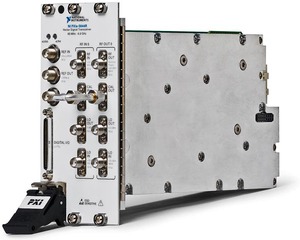 Under the continuous expansion of Moore's Law, the number of transistors per unit area continues to double. This trend has led to continuous improvement in product performance, while the size and cost have continued to decline. As the action of the device is already the mainstream, electronic products are moving toward the new trend of portability, which makes the wireless reception of signals become the focus of product design. Of course, in order to meet such needs, the development of measuring instruments has to keep pace.
Under the continuous expansion of Moore's Law, the number of transistors per unit area continues to double. This trend has led to continuous improvement in product performance, while the size and cost have continued to decline. As the action of the device is already the mainstream, electronic products are moving toward the new trend of portability, which makes the wireless reception of signals become the focus of product design. Of course, in order to meet such needs, the development of measuring instruments has to keep pace. However, there seems to be a question about it. Moore's Law makes electronic devices smaller and smaller. However, looking at the measuring instruments on the market today, the body size is getting bigger and bigger, and there is no tendency to reduce them. And the volume is no problem, the price has been maintained high. What has happened to Moore's Law on measuring instrument products? Cause these instruments unable to follow the pace of Moore's Law?
In fact, the diversification of the functions of electronic products is the main cause for the complexity of measuring instruments. Examples of today's electronic products, generally have wireless networking capabilities, from portable phones, tablet, to game consoles, televisions, refrigerators, washing machines. The variety of wireless technologies is complex, for example, from GSM, CDMA to LTE, WiMAX, and Wi-Fi 802.11a/b/g to n. Now there are 802.11ac, which is responsible for home multimedia transmission, waiting to go public, plus NFC, GPS , Zigbee, etc., due to the needs of the market, giving these devices a variety of wireless transmission capabilities.
However, these functions make the measurement equipment responsible for checking very large. It is difficult for the system manufacturer to purchase different instruments for measuring different requirements. How much costs do these manufacturers have to spend? How much space do you have to use to place these bulky instruments? And whether the used old instruments can meet the new measurement requirements through upgrading, instead of constantly buying new and expensive new instruments?
These problems all point to a new direction for the development of measuring instruments. That is, in order to meet the needs of a new generation of measurement applications, the market needs a measurement instrument that is small in size, low in price, scalable, and that can be modified by users themselves. This is why the National Instruments National Instruments (NI) announced its pioneering RF Signal Vector Transmitter (VST), which is to create an instrument for customers to meet advanced testing requirements in a cheaper way.
The NIPXIe-5644RRF vector signal transceiver is the world's first software-defined instrument. A single PXI modular instrument combines a vector signal generator and a vector signal analyzer together with a user-programmable FPGA. Engineers can use vector signal transceivers as a new instrument, or they can use NI's LabVIEW system design software to enhance existing features. VST is ideal for testing the latest wireless and mobile phone standards, such as 802.11ac and LTE.
Twenty-six years ago, NI created classic instruments using LabVIEW system design software. After a lapse of 26 years, NI's Vector Signal Transceiver (VST) is the latest in classical instruments. At the very beginning of the company's founding, NI had foreseen the importance of software to the instrument. On VST, it was even more evident that LabVIEW reformed the way engineers handled RF design and testing.
Target Flow Meter,Hydrogen Peroxide Flow Meter,Hydroperoxide Flow Meter
Pioneer Automation Instrument Co., Ltd. , http://www.lnvalves.com